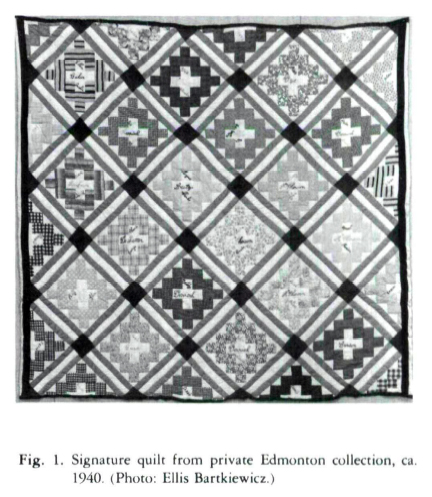Notes and Comments / Nouvelles brèves
History of Alberta Quilts
1 A research project was begun in June 1982 to develop an exhibition on the history of Alberta quilts. This project is being undertaken jointly by Sandra Morton, Curator of Social History, Provincial Museum of Alberta, Edmonton, and Elyse Eliot-Los, Curator, Muttart Gallery, Calgary. The exhibition will open at the Muttart Gallery on 11 September 1984, and will travel to various institutions within Alberta, ending at the Provincial Museum of Alberta in June-July 1985. It is hoped that it will continue on a national tour after that time. A bilingual catalogue will accompany the exhibition.
2 The exhibition will consist of approximately thirty quilts, 60 per cent historical and 40 per cent contemporary. As the history of immigration and settlement is so recent in Alberta compared with eastern Canada, quilts made as late as 1950 are being considered historical. The contemporary quilts in the exhibit will consist of both recent quilts done in traditional patterns as well as modern quilts of unique design, fabricated by Alberta artists.
3 An exhibition research grant from the Museum Assistance Programmes of the National Museums of Canada is assisting the documenting and photographing of quilts in the various geographic regions of the province. This phase of the project should be completed by December 1983, after which the quilts will be selected for the exhibition. Research is underway on quilts in several local Alberta museums as well as those in private hands. The various quilters' guilds in the province have assisted in locating many important quilts.
4 The earliest Alberta-made quilt located was made from felt pieces traded with the Indians at Fort Edmonton, ca. 1870. Some "crazy quilts" date from the 1870s as well. These were made from men's silk ties, grandma's wedding petticoats, and an assortment of other odd scraps such as silk cigar bands, prize ribbons, labels, and badges. Crazy quilts, a fashion of the Victorian era, were characterized by irregular shapes of luxury fabrics such as silk, satin, velvet and brocade stitched to a heavy cotton foundation. The seams between patches were embellished with elaborate embroidery.
5 An extremely popular pattern dating from the early 1900s to the late 1930s in Alberta was the Signature Quilt. These generally consisted of large squares, often of two alternating colours. These quilts have also been dubbed "Friendship" or "Family" quilts, since they were often composed of embroidered signatures of a family tree, or of schoolgirl classmates. They were sometimes made as fund-raisers for church raffles and other charities, whereby each person paid to have his or her name embroidered on the quilt.
6 Oral histories have revealed that during the 1930s many quilts were made of appliquéd fruit basket or animal motifs. The Depression also heralded quilts made of flour sacks, sugar sacks, unbleached cotton squares, dish towels, and even old policemen's uniforms.
 Display large image of Figure 1
Display large image of Figure 17 In recent years there has been a revival of quilting traditions, partly due to the invention of the light-weight polyester batting now used as filling, and partly due to the emergence of women fibre artists who are utilizing the quilt as the form of their artistic expression.